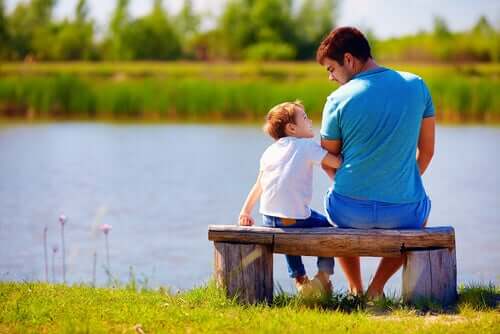When Should We Start Setting Limits for Our Children


Written and verified by the psychologist Úrsula Perona
When it comes to explaining to parents the importance of instilling discipline and starting setting limits, there’s a common metaphor:
“When you buy a small rambling rose and plant it next to the fence of your garden, you attach it to a post, tying its branches so they stay straight and grow in the right direction. If you don’t, the young rose bush will grow with its branches fallen on the ground, since they are fragile and don’t yet have the strength to hold themselves up. However, over time, we’ll come to remove these guides and ties, as the rose bush will start to gain strength and a time will come when the plant will be able to grab onto the fence itself.”
This explanation helps us understand the concept of scaffolding. Vygotsky – one of the fathers of child psychology – coined this term. It explains the need that children have for guides or “scaffolds” when they’re young.
With the passing of time, we must remove them – little by little – so that children can fend for themselves. Thanks to our guidance, they’ll have internalized the norms and values we’ve passed on.
So, if you’re asking yourself if setting limits for your children is the right thing to do, the answer is yes. Limits are necessary. They keep our children from disrespecting others and from behaving in ways that put them at risk.
But it’s about so much more than just that. Limits are fundamental when it comes to helping children feel safe and protected.
When there aren’t clear limits, children don’t know what’s expected of them, since they don’t have a clear guide to follow.

When should parents start setting limits?
Another common question that parents have is when they should start setting limits. They often think their kids are too small to understand.
However, from the time children are born, without us even realizing it, we already start setting limits. This is something natural, and completely necessary for our little ones.
Many parents might be thinking, “But when I tell them not to do something, they just want to do it even more.” This is normal. Small children consider this situation a game. What’s more, they’re learning to set their own limits!
Therefore, it’s important to be consistent with our rules and, above all, with the body language we use. That way, they’ll know we’re being serious.
There’s a series of non-verbal signs that accompany our verbal language which is very important. For example, the tone of voice, seriousness, and firmness with which we communicate a rule and the attitude with which we do it. These are fundamental to help our children understand what they can and cannot do.
When do children start to internalize rules?
Many parents feel somewhat frustrated when they come to the conclusion that they’re like a broken record… In other words, they’re always repeating the same rules to their children. When do children start to internalize rules and norms as their own? When do they stop misbehaving out of fear of being punished?

Educating children requires time and patience. Take a minute to think about yourself and in your own habits and quirks. Think about the things that you had a hard time changing, even when you made an effort.
And yet, you expect your kids to learn right off the bat. Children need a lot of “repetitions”, many “errors”, and many attempts before they learn and internalize desired behaviors.
At the same time, we’re not alone in educating our children. They also learn from society, school, their grandparents, other children, etc. As they develop in their socialization, our kids will receive education regarding socially desirable norms and values, not only from their families but also from all the environment where they interact.
Children need a clear guide to follow and a path that’s wide enough for them to develop fully.
When it comes to explaining to parents the importance of instilling discipline and starting setting limits, there’s a common metaphor:
“When you buy a small rambling rose and plant it next to the fence of your garden, you attach it to a post, tying its branches so they stay straight and grow in the right direction. If you don’t, the young rose bush will grow with its branches fallen on the ground, since they are fragile and don’t yet have the strength to hold themselves up. However, over time, we’ll come to remove these guides and ties, as the rose bush will start to gain strength and a time will come when the plant will be able to grab onto the fence itself.”
This explanation helps us understand the concept of scaffolding. Vygotsky – one of the fathers of child psychology – coined this term. It explains the need that children have for guides or “scaffolds” when they’re young.
With the passing of time, we must remove them – little by little – so that children can fend for themselves. Thanks to our guidance, they’ll have internalized the norms and values we’ve passed on.
So, if you’re asking yourself if setting limits for your children is the right thing to do, the answer is yes. Limits are necessary. They keep our children from disrespecting others and from behaving in ways that put them at risk.
But it’s about so much more than just that. Limits are fundamental when it comes to helping children feel safe and protected.
When there aren’t clear limits, children don’t know what’s expected of them, since they don’t have a clear guide to follow.

When should parents start setting limits?
Another common question that parents have is when they should start setting limits. They often think their kids are too small to understand.
However, from the time children are born, without us even realizing it, we already start setting limits. This is something natural, and completely necessary for our little ones.
Many parents might be thinking, “But when I tell them not to do something, they just want to do it even more.” This is normal. Small children consider this situation a game. What’s more, they’re learning to set their own limits!
Therefore, it’s important to be consistent with our rules and, above all, with the body language we use. That way, they’ll know we’re being serious.
There’s a series of non-verbal signs that accompany our verbal language which is very important. For example, the tone of voice, seriousness, and firmness with which we communicate a rule and the attitude with which we do it. These are fundamental to help our children understand what they can and cannot do.
When do children start to internalize rules?
Many parents feel somewhat frustrated when they come to the conclusion that they’re like a broken record… In other words, they’re always repeating the same rules to their children. When do children start to internalize rules and norms as their own? When do they stop misbehaving out of fear of being punished?

Educating children requires time and patience. Take a minute to think about yourself and in your own habits and quirks. Think about the things that you had a hard time changing, even when you made an effort.
And yet, you expect your kids to learn right off the bat. Children need a lot of “repetitions”, many “errors”, and many attempts before they learn and internalize desired behaviors.
At the same time, we’re not alone in educating our children. They also learn from society, school, their grandparents, other children, etc. As they develop in their socialization, our kids will receive education regarding socially desirable norms and values, not only from their families but also from all the environment where they interact.
Children need a clear guide to follow and a path that’s wide enough for them to develop fully.
This text is provided for informational purposes only and does not replace consultation with a professional. If in doubt, consult your specialist.








